Cerro Castillo trek (Las Horquetas) is a 50 km route through Cerro Castillo National Park, one of the best Patagonia National Parks for hiking. The scenery on the trek is stunning; indigenous forest, hanging glaciers, mountain rivers, snow peaks, turquoise blue lakes, bizarrely shaped mountains – untouched nature combined with unpredictable Patagonian weather.

There are different hiking routes in Cerro Castillo National Park. You can do a day hike to Laguna Cerro Castillo or a 4-day trek through the park. Compared to other multi-day hikes in Patagonia e.g. treks in El Chalten or backpacking in the famous Torres del Paine, Cerro Castillo has fewer people.
Table of Contents
Las Horquetas trek overview
- Total distance – 51 km/31,6 miles
- Days required – 3 to 4, we’d recommend 4 to have more time to enjoy the scenery but if you’re short on time you can push it to 3 days.
- Starting point – Valle de la Lima, Ruta 7.
- Finishing point – Cerro Castillo village.
- Average altitude – 1000m.
- Highest points – Cerro Castillo pass – 1600m and Portezuelo Peñon pass – 1435m.
- Permits – no special permits or guides are required.
- Entrance fee – for a multi-day trek is CLP 30 000/US$34 (paid at the gate), and for a day hike to Mirador Cerro Castillo is CLP 20 000/US$23.
Travel insurance for hiking in Patagonia
Who are World Nomads?
World Nomads’ mission is to support and encourage travelers to explore their boundaries.
They offer simple and flexible travel insurance and safety advice to help you travel confidently, destination guides and tips to help you plan your trip, and responsible travel insights to help you travel better
World Nomads provides travel insurance for travelers in over 100 countries. As an affiliate, we receive a fee when you get a quote from World Nomads using this link. We do not represent World Nomads. This is information only and not a recommendation to buy travel insurance.
Best time for trekking
Summer (December to March) – is the best time for hiking in Patagonia in general; nice and warm during the day (it rarely gets hot), and days are long (you have daylight till 9 pm) though it rains a lot in Patagonia any season be prepared to experience some rainfalls. We hiked in February and in general, were very lucky with the weather on this hike, not a single drop in 4 days.
In winter (June to August); night temperatures go down to -2°C and below, and days are cold and short, you’ll likely encounter snow on the trek. April and September are the months with the most rain probably the worst time for hiking. March, October, and November are quite cold though the temperature even at night stays above 0°C and it doesn’t rain too much.
Tips for trekking in Cerro Castillo
There are no shops or restaurants inside Cerro Castillo National Park you must be self-sufficient and bring all the equipment and food with you.
Some travelers consider the Cerro Castillo trek as a good (less crowded) alternative to the W trek in Torres del Paine.
There are 4 designated campsites (Rio Turibio, El Bosque, Porteadores, and Neozelandes) with basic facilities in the park where you’re allowed to camp, wild camping is not permitted.
Drinking water can be found everywhere (taps, rivers, lakes, falls), it’s good quality and drinkable. We didn’t use any purification tablets or a UV filter here.
Patagonian weather is unpredictable; strong winds and heavy rains are frequent so make sure your gear is right.
The hiking route is marked well, the only time we were unsure about it was at the beginning of the second day.
If you hike in summer, especially in December and January bring insect repellent there might be many tabanos (horseflies) in Patagonia this time of the year, they are very annoying.
Not many people in Patagonia speak English so basic knowledge of Spanish will help.
In peak season; January-February many people travel the Carretera Austral – a road through Patagonia. Sometimes it’s challenging to get on a bus because they are full. Hitchhiking in the area is safe, locals and tourists stop to pick up travelers. We hitched to Cerro Castillo from Pumalin Park and it worked out great.
How we rank Cerro Castillo trek
- Difficulty level – 3 out of 5, there are two steep ascents and descents on the way.
- Scenery – 4 out of 5, pine forest, lakes, glaciers, rivers – quite impressive landscape.
- Touristy – 2 out of 5, we hiked in February which is still high season but there were not many people, mostly Chileans, and very few foreigners – nothing compared to day hikes in Torres del Paine.

Cerro Castillo vs Torres del Paine
If you have to choose between visiting Carro Castillo or Torres del Paine National Parks I would recommend the second one. We’ve been to both parks and enjoyed hiking there but for me, the scenery in Torres del Paine is far more impressive than in Cerro Castillo. The attractions of Torres del Paine include some of the main Patagonia highlights such as Grey Glacier, Mirador Las Torres, Nordenjkold Lake, Mirador Frances, and Pehoe Lake. The scenery in Cerro Castillo is beautiful with the Mirador Cerro Castillo being the main highlight but I wouldn’t choose it over Torres del Paine.
The main advantage of Cerro Castillo is that it’s easier to arrange the hike. Unlike in Torres del Paine, you don’t have to book campsites in advance to be allowed to enter the park. It’s possible to do the Cerro Castillo trek last minute without too much planning. It’s cheaper to hike in Cerro Castillo than in Torres del Paine because the entrance fee includes camping. In Torres del Paine you pay the entrance fee + camping fee.
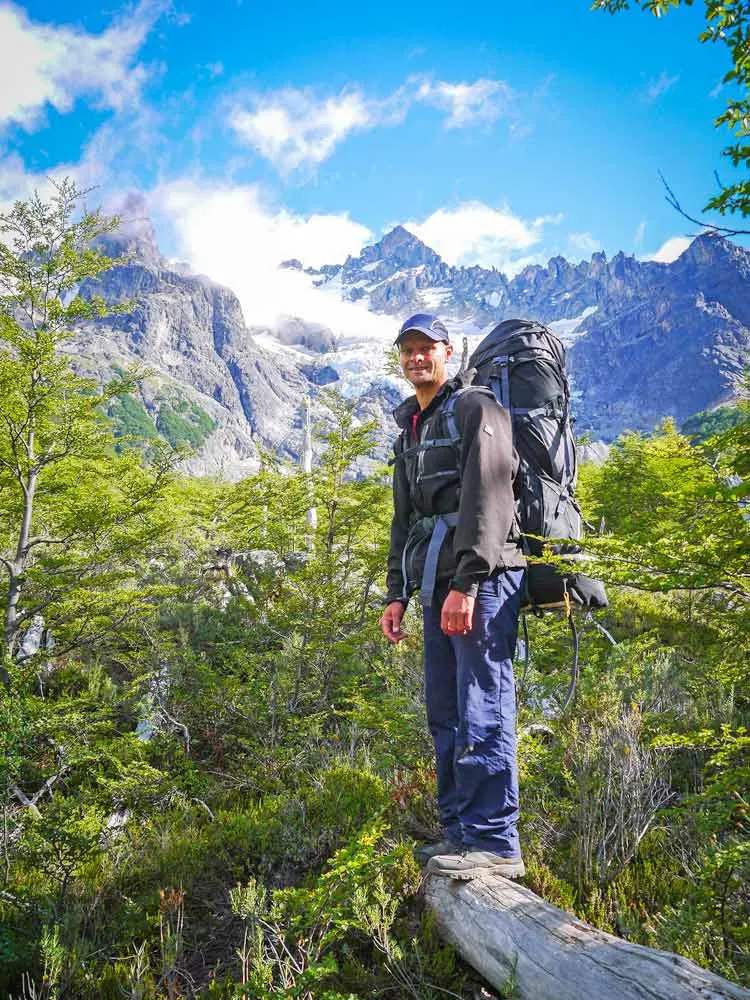
Where does the Cerro Castillo trek start and end?
The 4-day trek starts at the Las Horquetas entrance and finishes at the Estero Parada entrance. It’s walked from east to west.
Cerro Castillo National Park entrances
- Estero Prada Entrance (the start of a day hike) – from 7 am to 4 pm for hikers, from 7 am to 1 pm for day visitors.
- Entrance to Mirador Cerro Castillo (day hike) – from 7 am to 12 pm
- Entrance Las Horquetas (the start of the 4-day trek) – from 7 am to 1 pm.
Cerro Castillo trek cost
- Transport – CLP 10000/US$12 bus
- Shopping (food, gas) – CLP 9000/US$10
- Accommodation + entrance fee. If you do a multi-day hike, you pay CLP 30 000/US$34, including the entrance fee and overnight camping in the park. For more details on price check the official website.
Total: CLP 48 000/US$56
Distances on the Las Horquetas route
- Las Horquetas – campsite Río Turbio – 15 km/9,3 miles
- Rio Turbio – campsite Estero del Bosque – 12 km/7,4 miles
- El Bosque – campsite Neozelandes – 11 km/6,8 miles
- Neozelandés – Cerro Castillo village – 13 km/8 miles
Campsites in Cerro Castillo
Río Turbio, Day 1
Facilities
- Toilet – yes
- Running water – yes
- Tables, benches – yes
Estero del Bosque, Day 2 (it was moved 1 km on following the trail)
Facilities
- Toilet – yes
- Running water – yes
- Tables, benches – yes
Porteadores, Day 3
Facilities
- Toilet – yes
- Running water – yes
- Tables, benches – no
Neozelandes, Day 3
Facilities
- Toilet – yes
- Running water – yes
- Tables, benches – yes
How to get to Cerro Castillo?
Cerro Castillo National Park is about 75 km from Coyhaique, the capital of the region. To get there you can catch a daily bus from the Coyhaique terminal, which leaves around 9.00 am for CLP 10 000/US$11. The hike starts at Las Horquetas, about 30km before (if you drive from Coyhaique) Villa Cerro Castillo. If you go by bus just ask a bus driver to stop there.
To get to the Las Horquetas entrance from Villa Cerro Castillo you can get on a bus to Coyhaique that leaves at 7 am and get off at Las Horquetas.
We had some extra luggage and didn’t want to walk for 4 days with two backpacks each so we had to go first to Villa Cerro Castillo and ask to store our extra bags in one of the campsites (for free), we promised to stay there when we’re back.
As an option, you can hitchhike, depending on your luck and how many people are on the road you can wait for a long time or get a ride in 15 minutes.

You can find a new map of Cerro Castillo National Park here.
Cerro Castillo trek (Las Horquetas) – a 4-day itinerary
Day 1. Las Horquetas – Campamento Río Turbio, 15 km/9,3 mi
Trek starts at Las Horquetas a turn from Carretera Austral to the gravel road, between Coyhaique (75km) and Villa Cerro Castillo (30km). From the turn to the park entrance about 13km; easy walk, mostly flat, on the gravel road through fields and forest.
At the entrance, you register, pay CLP 30 000/US$34 entrance fee, and get a free map.
Highlights
- Indigenous forest
- The beautiful valley of Río Turbio
Challenges
- It was an easy day of walking without steep ascents or descents.
Day 2. Río Turbio – El Bosque, 12 km/7,4 mi
In the beginning nice easy walk through the forest along the river for about 4km at some stage. We lost the trail but found it quickly. Then only one long steep up on the hike to El Peñon pass, on top of it you’ll get a chance to walk on snow/ice in the middle of summer.
After an ascent there is always a descent; steep and rocky so be careful, don’t rush, and watch your step. Walk from the campsite to the pass and over it takes about 5 hours. Once down, it’s 1,5 hours more to El Bosque campsite. Note! In 2022 the campsite El Bosque was moved deeper into the forest. It’s a 40-minute walk from the original campsite which is closed for recovery.
There used to be another campsite La Tetera, about 1-hour walk from El Bosque but as of August 2022, it’s closed for recovery.
Highlights
- Stunning views from the top of El Peñon pass
- Snow and ice on the top of the pass
Challenges
- A steep ascent from the valley to El Pañon pass, +600m
- A steep and rocky descent from the pass, -700m
Day 3. El Bosque/La Tetera – camping Neozelandes, 11 km/6,8 mi
At the beginning of the day after a 1-hour walk you arrive at the lake – Laguna Cerro Castillo (you start there if you camped at La Tetera), one of the most impressive sceneries on the hike; turquoise color lake, hanging glacier, and mountains around. From the lake, you’ll start ascending to Cerro Castillo pass, 1600m.
Don’t forget to turn around from time to time to check the view, from the top of the pass it’s even more impressive. Once at the top, you start a steep long descent. You should be very careful it’s steep, rocky, and gets very windy.
After about 1,5 hours you’ll find yourself at Los Porteadores campsite near the river. Here you have several options; to camp at Los Porteadores and walk to Neozelandes without your backpack, to skip Neozelandes and go down to Cerro Castillo village, or to keep walking with your backpack, about 1,5 hours, to Neozelandes and camp there. We chose the last option and enjoyed it, the area around the campsite is absolutely beautiful; a green valley with a river surrounded by bizarre-shaped mountains. Camping Neozelandes was the least crowded, we were 6 people camping there.
If for some reason you don’t want or can’t continue the hike you can take an emergency route. From La Tetera walk up to the Mirador Cerro Castillo where you’ll see Sendero de Emergencia, a route that will take you straight to Villa Cerro Castillo. This route is used by day hikers to get from the town to Laguna Cerro Castillo and back in one day. The descent is very steep, about 900m down.
Highlights
- Turquoise blue lake Laguna Cerro Castillo
- Hanging Cerro Castillo Glacier
- Stunning views from the top of the pass
- A beautiful valley at Neozelandes campsite
Challenges
- A steep rocky ascent to Cerro Castillo pass, +700m
- A very steep and rocky descent from the pass, -800m
Day 4. Neozelandes – Villa Cerro Castillo, 13 km/8 mi
Last bit and only down, all the way to the road, about 3,5 hours and from there 1,5 hours to the village and campings.
At the exit, you can be asked to show your ticket and keep it till the end. The trekking is not very difficult but can be if the weather is bad, the path is well marked, no dangerous animals or poisonous snakes, and you walk between 6-7 hours daily.
Highlights
- Walking through the forest
Challenges
- A long descent to Villa Cerro Castillo – 800m
What to pack for the Cerro Castillo trek?
There are no accommodation options, restaurants, or shops inside the National Reserve bring with you all you need for three nights of camping.
Tent. For camping in Patagonia, we’d recommend having a good quality reliable tent that is waterproof and wind-resistant. After 5 years of traveling, hiking, and camping sometimes in very bad weather conditions, we bought an MSR Hubba Hubba NX tent. It’s light, pack small, easy to pitch, waterproof, and very stable in strong wind. They might be not the cheapest tents but will serve you for years without fail.
Camping mat. We are both entirely for an inflatable camping pad. It’s small and light, easy to wash, fits inside a backpack, soft and comfortable.
Sleeping bag. If you’re going to Patagonia in summer 0°C comfort sleeping back will be good enough, in other seasons we’d recommend bringing a bag with comfort to -5°C. I prefer a down sleeping bag. They are lighter, pack smaller, warm, very soft, and comfortable but if they get wet it’ll be a problem.
Cooking gear (stove, pots, gas). We recommend bringing a stove to be able to cook hot meals and boil water for tea. Modern camping stoves are very light and small and will hardly add 500 grams to your backpack weight. Buy a stove with Piezo Ignition to have a backup in case you lose a lighter or matches get wet.
As for pots we always take two pots with lids (that we use as plates); one for cooking and one for boiling water. You’ll be able to buy gas in almost any town in Patagonia. You can buy a cooking set with a stove, pots, and utensils.
More details on hiking and camping gear for Patagonia can be found in our Patagonia packing list post.
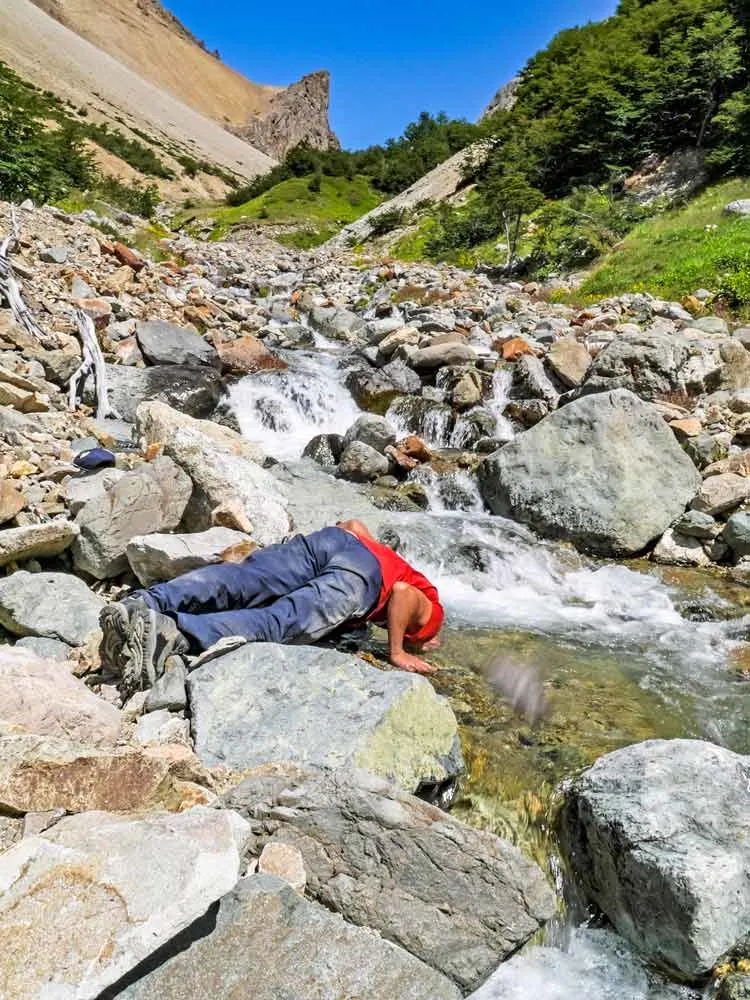
Mirador Cerro Castillo – one day hike
It’s possible to do a one-day hike to the Mirador Cerro Castillo from where you can see the lake and Cerro Castillo glacier. In my opinion, it’s one of the best day hikes in Patagonia.
- Starting and finishing point – Villa Cerro Castillo
- Distance – 12km return
- Altitude gain/loss – 900m ascent to the Mirador (viewpoint) with subsequent 900m descent back to the valley.
- The time required – 6-7 hours
- Permits – no special permits are required. The entrance fee is CLP 19 000/US$22 is charged at the entrance. For a day hike access to the trail is from 7 am to 12 pm. It’s done to ensure you’ll have enough time to descend before it gets dark.
Mirado Cerro Castillo hike with a tour
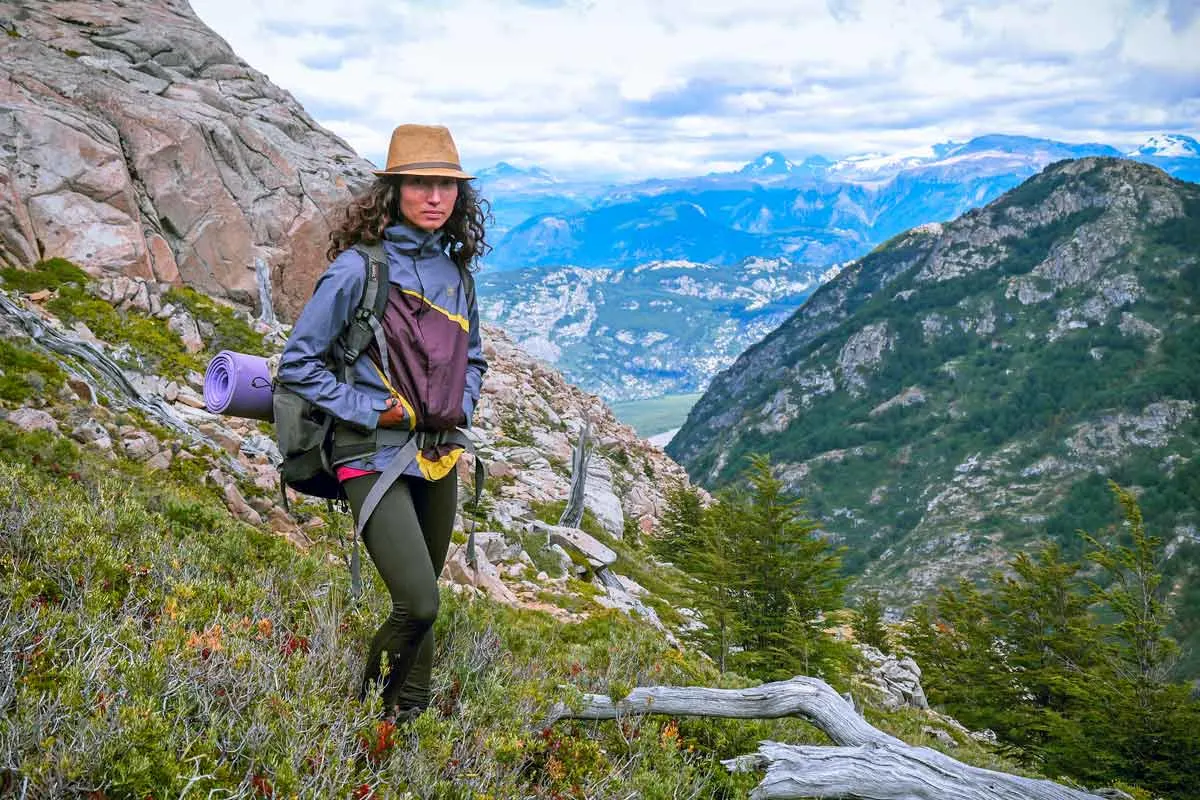
How to get to Laguna Cerro Castillo hike?
The trek starts at Villa Cerro Castillo, take a bus or hitchhike from Coyhaique. Once there find a sign “Sendero de Chile” and follow the road until you reach a check-point. There you pay the entrance fee of CLP 19 000/US$22 and start a steep ascend to the Mirador.
Day hikers to Laguna Cerro Castillo have to ascend and descend following the same trail. It’s not allowed to enter or exit through the Estera Prado Entrance (the entrance for the circuit). Day hikers are not allowed to descend to the lake as it takes too much time.
Highlights
- Laguna Verde
- Cerro Castillo Glacier
- Views from the Mirador
Challenges
- A very steep and long ascent from Villa Cerro Castillo to the Mirador, 900 m up
- A steep and long descent back to the town, 900 m down

Laguna Cerro Castillo packing list
- Water bottle
- Snacks, sandwiches – it’s a 7-hour hike you’ll get hungry.
- Sunglasses
- Cap
- Rain jacket
- Hiking poles will be useful on the way down, it’s steep and long.
- Sunscreen – on a sunny day it’s a must.
- Insect repellent – there might be sandflies, they are very annoying.
Where to stay before trekking in Cerro Castillo?
For Patagonia, Coyhaique is quite a big place. It’s the last town with good infrastructure down south till El Chalten in Argentina or Puerto Natales in Chile. If you need to upgrade your gear, buy gas, draw cash – it’s the place to do it. There are a couple of gear and second-hand shops (Ropa Americana) in the town, which was quite important for me because on the way to Coyhaique, I lost my backpack with all my clothes, it fell out of the car while we were hitchhiking.
Coyhaique facilities
- Hotels – yes
- Campsites – yes
- Supermarket, shops – yes, big Unimark and one or two outdoor gear shops
- Restaurants, cafes – yes
- ATMs – yes
- Information office – yes
Accommodation in Coyhaique
There are many guest houses, hotels, hostels, and campsites in the town. If you are on a tight budget bring a tent – camping is the only budget accommodation option in this part of Patagonia. We can recommend El Camping. It’s a bit outside of the town. It has good facilities; hot shower, wi-fi, power outlets but no kitchen you need your cooking gear, the price is CLP 11 000/US$13 per person.
- Budget | Patagon Backpackers | Casa Balmaceda Backpackers |
- Middle price | Hostal Viento Sur |
- High-end | Los Mañios | Huellas y Senderos Hotel |
The Las Horquetas 4-day hike finishes in Villa Cerro Castillo. It’s a small town with a couple of restaurants, a shop or two, and small guest houses/cabins and campsites. For more accommodation and restaurant options go back to Coyhaique.
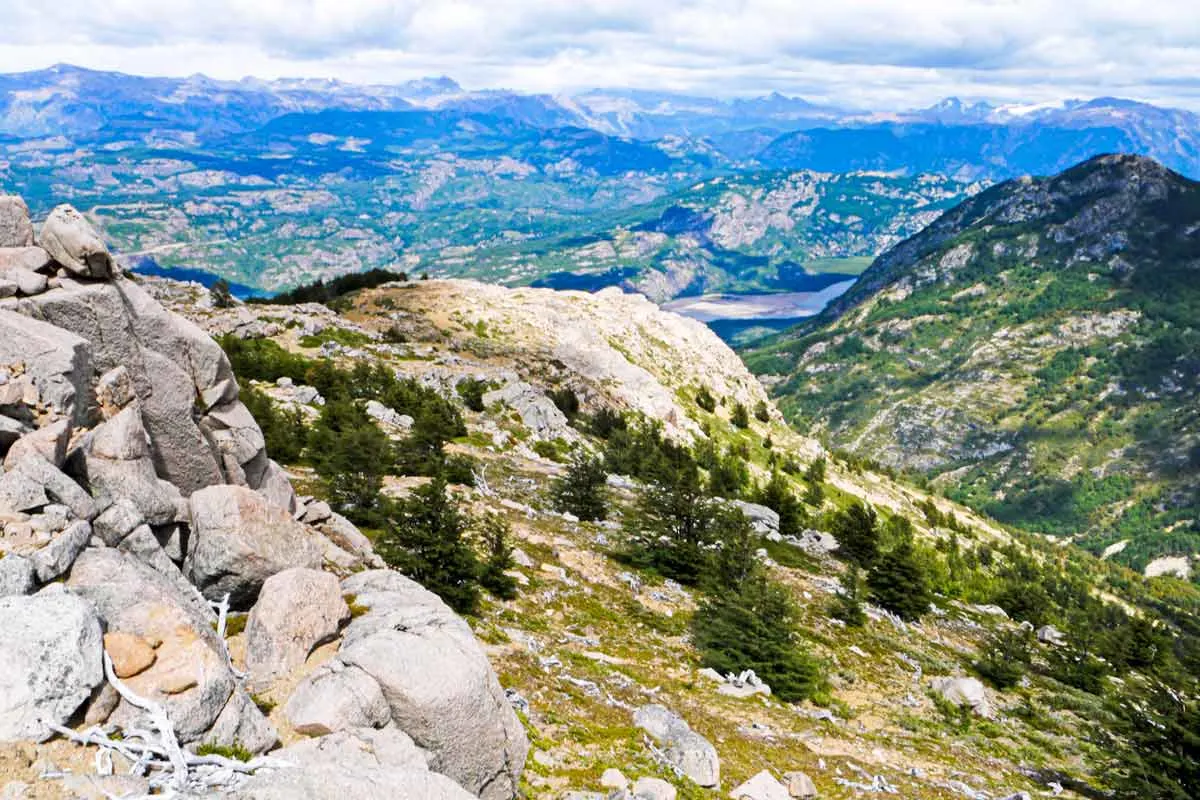
Villa Cerro Castillo facilities
- Hotel – yes, a couple of guest houses and cabins (cabañas)
- Campsite – yes, several around the town
- Shop – yes, a couple of smallish shops
- Restaurant – yes, several local restaurants
- ATM – no
- Tourist information – yes
Accommodation in Villa Cerro Castillo
| Hospedaje Cabaña y Restaurante Don Niba | QUELEN PATAGONIA | B&B y Cabañas Cerro Castillo |
How to get from Villa Cerro Castillo to Coyhaique?
If you arrive in the town early you’ll have a chance to catch a bus back to Coyhaique the same day. There are two or three daily buses from Cochrane to Coyhaique but in the season they might be full. Go to the tourist information office just a block away from Carretera Austral. You can try to hitchhike but it can be difficult due to the many people on the road – dozens of backpackers locals and foreigners hoping to get a ride.
How to get from Villa Cerro Castillo to Puerto Río Tranquilo?
If hitch-hiking is not your cup of tea you can catch a bus just need to know that public transport is very scarce in the area. There is a bus at 11 am to Cochrane, the price is 9000 pesos/US$10. In our experience the bus was already full when arrived, some people could get in. We hitched to Puerto Río Tranquilo, 120km south of Villa Cerro Castillo, and were very lucky to get a ride quickly.
Recommended books and guidebooks
- Lonely Planet Chile and Easter Island, Travel Guide, Kindle, and paperback.
- Patagonia on a budget by Matthew Morgante. How to travel Patagonia on US$30 a day, Kindle.
- Walking Patagonia by Caspian Ray. Don’t expect a hiking guide, it’s a fiction story about a young guy who went to Patagonia in search of adventure and love.
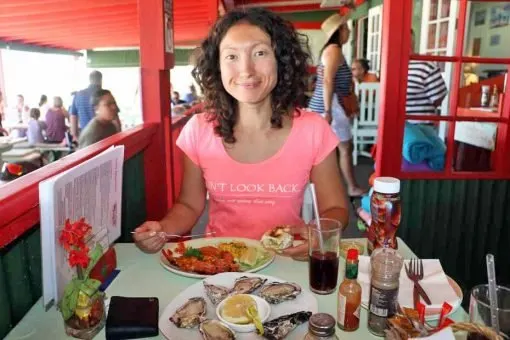
The pretty half of Stingy Nomads, responsible for all our land adventures (hiking, climbing, walking the Camino) and following them write-ups. Alya loves walking since she was a child, she prefers to walk 1000 km with a backpack rather than to do a 10 000 km road trip (actually any road trip). Alya is a big fan of Latin America, the Spanish language, and dancing. Every time we go away she desperately misses our dog Chile.








Ed
Wednesday 5th of March 2025
Hello, thank you for this post.
I would like to do this trekking mid october 2025.
Wil the trek be open in october?
Gr Ed
Stingy Nomads
Friday 7th of March 2025
Hello Ed. As far as I know the trek is still closed in October. I think they opened it last year in late November-beginning of December. The main reason is that in October there will be still snow in the mountain parts of the route. I believe the W trek in Torres del Paine should be open by then. If you don't find a better alternative for that time of the year you can do that one. Cheers
Ewa
Thursday 7th of September 2023
Thank you for the article! It is really helpful :) I am wondering if there is something similar in Patagonia but you rated the scenery at 5 :D
Stingy Nomads
Thursday 7th of September 2023
Hello Ewa. Thank you for the comment. I've found the scenery on the O circuit and the W trek in Torres del Paine one of the most impressive in Patagonia. If I compare the Cerro Castillo trek to them it's a 4. These two routes are definitely a 5. El Chalten in Argentina has some impressive scenery as well. Cheers
Andrew
Tuesday 27th of September 2022
Hey dude thanks for all the info! Your site has been great during our trip. After dropping your extra stuff in villa Cerro castillo, how do you get to trailhead? We were thinking of just hitching but since you have to start before 1pm a bus might be a better option if available.
Also, did y'all head south after this? Looking to get to El Chalten after but it doesn't look easy to get to from coyhaique. Thank you!
Andrew
Thursday 29th of September 2022
@Stingy Nomads, hey thanks for the response. Unfortunately the border is closed down near O'Higgins and apparently has been for 2 years now. I was told there hasn't been a date announced to reopen so we're gunna have to go up and around. Sounds like it would have been awesome though!
Stingy Nomads
Tuesday 27th of September 2022
Hello Andrew. Thank you for your comment. We hitchhiked from Villa Cerro Castillo to the start of the trek. In the 2 months we spent in Patagonia we hadn't taken one bus we hitchhiked everywhere and it worked very well for us. If there is an early bus and you can get on it I would recommend taking it. You never know with hitchhiking you might be lucky and get a ride immediately or unlucky and spend most of the day waiting for a ride. We traveled in the peak season buses were always full that's why we didn't even bother. After hiking the Cerro Castilo circuit, we went south to Torres del Paine through El Chalten. We crossed to El Chalten from Villa O'Higgins. We have detailed posts on that crossing, El Chalten, Torres del Paine, etc. You can find them here https://stingynomads.com/patagonia/ Good luck
Matias Yudelevich
Wednesday 17th of August 2022
Hi, thank you for the great article and information. Do you have by any chance the itinerary to do the hike in 3 days. I am used to long, challenging hikes and a bit constrained with time. Which camp should I skip and keep going? Should I just combine two legs or their is a way to make each leg longer? Thanks in advance!
Stingy Nomads
Wednesday 17th of August 2022
Hello Marias. Thank you for the comment. If you want to walk the Cerro Castillo Circuit in 3 days instead of 4 you will have to combine two days in one. There is no way to make each stage a bit longer. Hikers are allowed to camp only at designated campsites wild camping is not allowed in Cerro Castillo. Which two days to combine it's up to you. The easiest is probably to combine the last two days. Cheers
Daniel Bethancourt
Wednesday 29th of December 2021
Hi, thanks so much for the good info here!
Unfortunately was a little late to the party on booking O trek campsites, so looking for alternatives now.
A friend and I have ~2 weeks to spend from mid February to beginning of March and this looks like an awesome trip. Are there any other treks (similar in length 4+ days) you would recommend pairing with this one?
The O'Higgins Glacier trip sounded like it could go well, but open to other options. We're in good shape and have some good backpacking (including some true backcountry) experience.
Thanks!
Daniel Bethancourt
Saturday 8th of January 2022
@Stingy Nomads, this is amazing. Thank you so much - love and appreciate the resources you've put together!
Stingy Nomads
Wednesday 29th of December 2021
Hello, Daniel. Thank you for the comment. It's a bummer that you were too late for the O Circuit though I'd suggest keeping an eye on the campsites it's very possible there will be cancellations. End of February - March is not the peak season in the park. As for alternative treks, I'd start with the Cerro Castillo, it's a 3-day trek, then O'Higgins to El Chalten walk, 2 days (+ 2 days if you walk to the O'Higgins Glacier), and then the Huemul Circuit in El Chalten (this one is quite a challenging route), another 3-4 days. In total, you get about 10 days of trekking plus a couple of days in between. It's only a suggestion there are many other beautiful treks in the region. We have a post on the best long-distance treks in Patagonia https://stingynomads.com/long-distance-treks-patagonia/. Look though maybe you'll find more treks that you'd like to do. Good luck